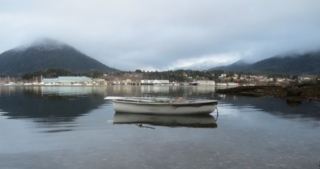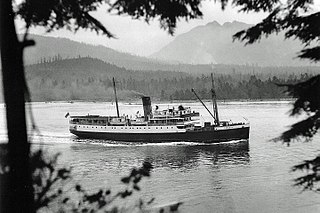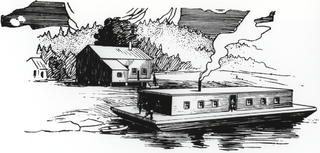
The Skeena River is the second-longest river entirely within British Columbia, Canada. Since ancient times, the Skeena has been an important transportation artery, particularly for the Tsimshian and the Gitxsan—whose names mean "inside the Skeena River" and "people of the Skeena River," respectively. The river and its basin sustain a wide variety of fish, wildlife, and vegetation; and communities native to the area depend on the health of the river. The Tsimshian migrated to the Lower Skeena River, and the Gitxsan occupy territory of the Upper Skeena.

The North Coast Regional District is a quasi-municipal administrative area in British Columbia. It is located on British Columbia's west coast and includes Haida Gwaii, the largest of which are Graham Island and Moresby Island. Its administrative offices are in the City of Prince Rupert.
Kitselas, Kitsalas or Gits'ilaasü are one of the 14 tribes of the Tsimshian nation of British Columbia, in northwestern Canada. The original name Gits'ilaasü means "people of the canyon." The tribe is situated at Kitselas, British Columbia, at the upper end of Kitselas Canyon, which is on the Skeena River. It was once a great trading nexus, just outside and upriver from the city of Terrace. It is the most upriver of the 14 tribes and it borders the territory of the Gitxsan nation.
The Gitzaxłaał are one of the 14 tribes of the Tsimshian nation in British Columbia, Canada, and one of the nine of those tribes making up the "Nine Tribes" of the lower Skeena River resident at Lax Kw'alaams, B.C. The name Gitzaxłaał means literally "people of ." Their traditional territory includes the watershed of the Ecstall River, a tributary of the Skeena River, including the now abandoned town, Port Essington, B.C. They also own areas on Dundas Island. Since 1834, they have been based at Lax Kw'alaams, when a Hudson's Bay Company fort was established there.

Port Essington was a cannery town on the south bank of the Skeena River estuary in northwestern British Columbia, Canada, between Prince Rupert and Terrace, and at the confluence of the Skeena and Ecstall Rivers. It was founded in 1871 by Robert Cunningham and Thomas Hankin and was for a time the largest settlement in the region. During its heyday it was home to an ethnic mix of European-Canadians, Japanese-Canadians, and members of First Nations from throughout the region, especially Tsimshians from the Kitselas and Kitsumkalum tribes. In the Tsimshian language, the site of Port Essington is called Spaksuut or, in English spelling, "Spokeshute", which means "autumn camping place". This also became the Tsimshian name for the town of Port Essington, and was conferred on Spokeshute Mountain, which stands above and behind the community. It sits on the traditional territory of the Gitzaxłaał tribe, one of the nine Tsimshian tribes based at Lax Kw'alaams. In 1888, the anthropologist Franz Boas visited Port Essington, interviewing Haida and Tsimshian individuals and establishing a working relationship with Odille Morison, the Tsimshian linguist, who lived in Port Essington.
William Henry Pierce (1856-1948), also known as W. H. Pierce, was a Canadian First Nations missionary for the Methodist church and a member of the Tsimshian nation in northwestern British Columbia. He is best known for his memoir, From Potlatch to Pulpit, which was the first published book by a Tsimshian.
Constance Cox was a Canadian schoolteacher of part Tlingit ancestry who lived and taught with the Gitksan First Nation in northwestern British Columbia and served as interpreter for several anthropologists.

The District of Port Edward is a district municipality of approximately 577, located in the Range 5 Coast Land District of British Columbia, Canada. It is situated on the Tsimpsean Peninsula, at Porpoise Harbour, near the southern end of Chatham Sound, close to the mouth of the Skeena River, 15 km (9 mi) southeast of Prince Rupert.
Robert Cunningham (1837–1905) was a British-Canadian lay missionary turned entrepreneur who founded the town of Port Essington, British Columbia.

The Skeena River is British Columbia’s fastest flowing waterway, often rising as much as 17 feet (5.2 m) in a day and fluctuating as much as sixty feet between high and low water. For the steamboat captains, that wide range made it one of the toughest navigable rivers in British Columbia. Nevertheless, at least sixteen paddlewheel steamboats plied the Skeena River from the coast to Hazelton from 1864 to 1912.

John Henry Bonser was a steamship captain from Oregon, United States and British Columbia, Canada. He piloted dozens of sternwheelers over his 40-year-long career and pioneered many rivers in the Pacific Northwest.

Porcher Island is an island in Hecate Strait, British Columbia, Canada, near the mouth of the Skeena River and southwest of the port city of Prince Rupert. The locality of Porcher Island is located near the island's northern tip at Humpback Bay, 54°05′11″N130°23′23″W. Stephens and Prescott Islands are located off its northwestern tip.

Hazelton was a sternwheeler that worked on the Skeena River in British Columbia, Canada from 1901 until 1912. Her first owner was Robert Cunningham who ran a freighting business that served the communities along the Skeena River.

Mount Royal was a sternwheeler that worked on the Skeena River and Stikine Rivers in British Columbia, Canada, from 1902 until 1907. She was named after Lord Strathcona who was also known as Donald Smith, 1st Baron Strathcona and Mount Royal.

The Inlander was a sternwheeler that worked on the Skeena River in British Columbia, Canada from 1910 until 1912. She was owned by the Prince Rupert and Skeena River Navigation Company which was a syndicate of Skeena River businessmen who planned to use the Inlander as a passenger and freight steamer during the busy years of Grand Trunk Pacific Railway construction.

For more than 35 years, from 1923 to 1958, the Union steamship Cardena sailed the British Columbia Coast, carrying passengers, groceries, dry goods, industrial cargo, mail and sundry other supplies to the 200 or so mining, logging and fishing communities that once dotted the province's coastline during the early years of the 20th century. On her return voyage, at the peak of the summer fishing season, Cardena routinely carried thousands of cases of canned salmon to the railheads at Prince Rupert and Vancouver for shipment across Canada and around the world. And so it went for the better part of half a century; a regular and reliable marine service that made Cardena a coastal institution, remembered with affection and regard by the countless men, women and children who inhabited those tiny outports in a bygone era.

A salmon cannery is a factory that commercially cans salmon. It is a fish-processing industry that became established on the Pacific coast of North America during the 19th century, and subsequently expanded to other parts of the world that had easy access to salmon.

Monte Cristo was a sternwheel steamboat which was operated in Puget Sound and the coastal rivers of the state of Washington and the province of British Columbia.

Camosun was a steamship built in 1904 in Paisley, Scotland which served in British Columbia.
The Ecstall River is a tributary of the Skeena River in the province of British Columbia, Canada. It originates in the Kitimat Ranges, and flows about 110 km (68 mi) to the lower tidal reach of the Skeena River at Port Essington, about 30 km (19 mi) southeast of Prince Rupert, 95 km (59 mi) southwest of Terrace, and 85 km (53 mi) northwest of Kitimat. Its drainage basin covers about 1,485 km2 (573 sq mi) and contains the largest blocks of unlogged land on the north coast of British Columbia, although large-scale industrial logging operations, both active and proposed, have been occurring in the watershed since the 1980s.